Fine Structure of High-Energy Pulses from a Stimulated Brillouin Scattering-Assisted Q-Switch Tm-Doped Fiber Laser
Abstract
1. Introduction
2. Experimental Setup
3. Experimental Results and Discussion
4. Potential Application
5. Conclusions
Author Contributions
Funding
Institutional Review Board Statement
Informed Consent Statement
Data Availability Statement
Conflicts of Interest
References
- Zhang, J.; Schulze, F.; Mak, K.F.; Pervak, V.; Bauer, D.; Sutter, D.; Pronin, O. High-Power, High-Efficiency Tm:YAG and Ho:YAG Thin-Disk Lasers. Laser Photonics Rev. 2018, 12, 1700273. [Google Scholar] [CrossRef]
- Walsh, B.M. Review of Tm and Ho Materials; Spectroscopy and Lasers. Laser Phys. 2009, 19, 855–866. [Google Scholar] [CrossRef]
- Shi, W.; Fang, Q.; Zhu, X.; Norwood, R.A.; Peyghambarian, N. Fiber lasers and their applications. Appl. Opt. 2014, 53, 6554–6568. [Google Scholar] [CrossRef] [PubMed]
- Polder, K.D.; Bruce, S. Treatment of Melasma Using a Novel 1,927-nm Fractional Thulium Fiber Laser: A Pilot Study. Dermatol. Surg. 2012, 38, 199–206. [Google Scholar] [CrossRef] [PubMed]
- Kopyeva, M.S.; Filatova, S.A.; Kamynin, V.A.; Trikshev, A.I.; Kozlikina, E.I.; Astashov, V.V.; Loschenov, V.B.; Tsvetkov, V.B. Ex Vivo Exposure to Soft Biological Tissues by the 2-μm All-Fiber Ultrafast Holmium Laser System. Appl. Sci. 2022, 12, 3825. [Google Scholar] [CrossRef]
- Kopyeva, M.S.; Filatova, S.A.; Kamynin, V.A.; Trikshev, A.I.; Kozlikina, E.I.; Astashov, V.V.; Loschenov, V.B.; Tsvetkov, V.B. Ex-Vivo Exposure on Biological Tissues in the 2-μm Spectral Range with an All-Fiber Continuous-Wave Holmium Laser. Photonics 2021, 9, 20. [Google Scholar] [CrossRef]
- Mingareev, I.; Weirauch, F.; Olowinsky, A.; Shah, L.; Kadwani, P.; Richardson, M. Welding of Polymers Using a 2 μm Thulium Fiber Laser. Opt. Laser Technol. 2012, 44, 2095–2099. [Google Scholar] [CrossRef]
- Petrovich, M.N.; Poletti, F.; Wooler, J.P.; Heidt, A.M.; Baddela, N.K.; Li, Z.; Gray, D.R.; Slavík, R.; Parmigiani, F.; Wheeler, N.V.; et al. Demonstration of Amplified Data Transmission at 2 μm in a Low-Loss Wide Bandwidth Hollow Core Photonic Bandgap Fiber. Opt. Express 2013, 21, 28559. [Google Scholar] [CrossRef]
- Zhang, H.; Kavanagh, N.; Li, Z.; Zhao, J.; Ye, N.; Chen, Y.; Wheeler, N.V.; Wooler, J.P.; Hayes, J.R.; Sandoghchi, S.R.; et al. 100 Gbit/s WDM Transmission at 2 μm: Transmission Studies in Both Low-Loss Hollow Core Photonic Bandgap Fiber and Solid Core Fiber. Opt. Express 2015, 23, 4946. [Google Scholar] [CrossRef]
- De Young, R.J.; Barnes, N.P. Profiling Atmospheric Water Vapor Using a Fiber Laser Lidar System. Appl. Opt. 2010, 49, 562. [Google Scholar] [CrossRef]
- Spiers, G.D.; Menzies, R.T.; Jacob, J.; Christensen, L.E.; Phillips, M.W.; Choi, Y.; Browell, E.V. Atmospheric CO2 Measurements with a 2 μm Airborne Laser Absorption Spectrometer Employing Coherent Detection. Appl. Opt. 2011, 50, 2098. [Google Scholar] [CrossRef] [PubMed]
- Sennaroglu, A.; Demirbas, U.; Vermeulen, N.; Ottevaere, H.; Thienpont, H. Continuous-Wave Broadly Tunable Cr2+:ZnSe Laser Pumped by a Thulium Fiber Laser. Opt. Commun. 2006, 268, 115–120. [Google Scholar] [CrossRef]
- Jung, M.; Han Lee, J. Actively Q-Switched, Thulium–Holmium-Codoped Fiber Laser Incorporating a Silicon-Based, Variable-Optical-Attenuator-Based Q Switch. Appl. Opt. 2013, 52, 2706. [Google Scholar] [CrossRef] [PubMed]
- Li, F.; Zhu, H.; Zhang, Y. High-Power Widely Tunable Q-Switched Thulium Fiber Lasers. Laser Phys. Lett. 2015, 12, 095102. [Google Scholar] [CrossRef]
- Fale, A.E.; Zverev, A.D.; Kamynin, V.A.; Wolf, A.A.; Filatova, S.A.; Nanii, O.E.; Smirnov, A.P.; Fedoseev, A.I.; Tsvetkov, V.B. The Dynamics of Multi-Peak Pulsed Generation in a Q-Switched Thulium-Doped Fiber Laser. Photonics 2022, 9, 846. [Google Scholar] [CrossRef]
- Wang, Y.; Xie, G.; Xu, X.; Di, J.; Qin, Z.; Suomalainen, S.; Guina, M.; Härkönen, A.; Agnesi, A.; Griebner, U.; et al. SESAM Mode-Locked Tm:CALGO Laser at 2 µm. Opt. Mater. Express 2015, 6, 131. [Google Scholar] [CrossRef]
- Ma, W.; Wang, T.; Su, Q.; Wang, F.; Zhang, J.; Wang, C.; Jiang, H. 1.9 µm Square-Wave Passively Q-Witched Mode-Locked Fiber Laser. Opt. Express 2018, 26, 12514. [Google Scholar] [CrossRef]
- Cho, W.B.; Schmidt, A.; Yim, J.H.; Choi, S.Y.; Lee, S.; Rotermund, F.; Griebner, U.; Steinmeyer, G.; Petrov, V.; Mateos, X.; et al. Passive Mode-Locking of a Tm-Doped Bulk Laser near 2 µm Using a Carbon Nanotube Saturable Absorber. Opt. Express 2009, 17, 11007. [Google Scholar] [CrossRef]
- Gatti, D.; Galzerano, G.; Toncelli, A.; Tonelli, M.; Laporta, P. Actively Mode-Locked Tm-Ho:LiYF4 and Tm-Ho:BaY2F8 Lasers. Appl. Phys. B 2006, 86, 269–273. [Google Scholar] [CrossRef]
- Tang, Y.; Xu, J. Model and Characteristics of Self-Pulsing in Tm3+-Doped Silica Fiber Lasers. IEEE J. Quantum Electron. 2011, 47, 165–171. [Google Scholar] [CrossRef]
- Liu, C.; Luo, Z.; Huang, Y.; Qu, B.; Cheng, H.; Wang, Y.; Wu, D.; Xu, H.; Cai, Z. Self-Mode-Locked 2 µm Tm3+-Doped Double-Clad Fiber Laser with a Simple Linear Cavity. Appl. Opt. 2014, 53, 892. [Google Scholar] [CrossRef] [PubMed]
- Kirsch, D.C.; Bednyakova, A.; Varak, P.; Honzatko, P.; Cadier, B.; Robin, T.; Fotiadi, A.; Peterka, P.; Chernysheva, M. Gain-Controlled Broadband Tuneability in Self-Mode-Locked Thulium-Doped Fibre Laser. Commun. Phys. 2022, 5, 219. [Google Scholar] [CrossRef]
- Jiang, M.; Tayebati, P. STable 10 Ns, Kilowatt Peak-Power Pulse Generation from a Gain-Switched Tm-Doped Fiber Laser. Opt. Lett. 2007, 32, 1797. [Google Scholar] [CrossRef] [PubMed]
- Simakov, N.; Hemming, A.; Bennetts, S.; Haub, J. Efficient, Polarised, Gain-Switched Operation of a Tm-Doped Fibre Laser. Opt. Express 2011, 19, 14949. [Google Scholar] [CrossRef] [PubMed]
- Koo, J.; Shin, W. Nanosecond Pulse Generation from Actively Q-Switched Thulium-Doped Fiber Laser Using a High-Speed Optical Switch. In Fiber Lasers XV: Technology and Systems; SPIE: Bellingham, WA, USA, 2018. [Google Scholar] [CrossRef]
- Coluccelli, N.; Galzerano, G.; Laporta, P.; Parisi, D.; Toncelli, A.; Tonelli, M. Room-Temperature Q-Switched Tm:BaY2F8 Laser Pumped by CW Diode Laser. Opt. Express 2006, 14, 1518. [Google Scholar] [CrossRef] [PubMed]
- Sadovnikova, Y.E.; Kamynin, V.A.; Kurkov, A.S.; Medvedkov, O.I.; Marakulin, A.V.; Minashina, L.A. Q-Switching of a Thulium-Doped Fibre Laser Using a Holmium-Doped Fibre Saturable Absorber. Quantum Electron. 2014, 44, 4–6. [Google Scholar] [CrossRef]
- Zverev, A.D.; Kamynin, V.A.; Trikshev, A.I.; Kovtun, E.Y.; Arutyunyan, N.R.; Mastin, A.A.; Ryabochkina, P.A.; Obraztsova, E.D.; Tsvetkov, V.B. Influence of Saturable Absorber Parameters on the Operation Regimes of a Dumbbell-Shaped Thulium Fibre Laser. Quantum Electron. 2021, 51, 518–524. [Google Scholar] [CrossRef]
- Luo, Z.; Liu, C.; Huang, Y.; Wu, D.; Wu, J.; Xu, H.; Cai, Z.; Lin, Z.; Sun, L.; Weng, J. Topological-Insulator Passively Q-Switched Double-Clad Fiber Laser at 2 μm Wavelength. IEEE J. Select. Top. Quantum Electron. 2014, 20, 0902708. [Google Scholar] [CrossRef]
- Chernikov, S.V.; Zhu, Y.; Taylor, J.R.; Gapontsev, V.P. Supercontinuum Self-Q-Switched Ytterbium Fiber Laser. Opt. Lett. 1997, 22, 298. [Google Scholar] [CrossRef]
- Fotiadi, A.A.; Mégret, P.; Blondel, M. Dynamics of a Self-Q-Switched Fiber Laser with a Rayleigh–Stimulated Brillouin Scattering Ring Mirror. Opt. Lett. 2004, 29, 1078. [Google Scholar] [CrossRef]
- Grukh, D.A.; Kurkov, A.S.; Razdobreev, I.M.; Fotiadi, A.A. Self-Q-Switched Ytterbium-Doped Cladding-Pumped Fibre Laser. Quantum Electron. 2002, 32, 1017–1019. [Google Scholar] [CrossRef]
- Hou, S.; Lou, Y.; Zhao, N.; Chen, P.; Zhang, F.; Chen, Y.; Lin, F.; Li, J.; Yang, L.; Peng, J.; et al. Robust Q-Switching Based on Stimulated Brillouin Scattering Assisted by Fabry-Perot Interference. Opt. Express 2019, 27, 5745. [Google Scholar] [CrossRef] [PubMed]
- Tang, Y.; Li, X.; Wang, Q.J. High-Power Passively Q-Switched Thulium Fiber Laser with Distributed Stimulated Brillouin Scattering. Opt. Lett. 2013, 38, 5474. [Google Scholar] [CrossRef] [PubMed]
- Fotiadi, A.A.; Mégret, P. Self-Q-Switched Er-Brillouin Fiber Source with Extra-Cavity Generation of a Raman Supercontinuum in a Dispersion-Shifted Fiber. Opt. Lett. 2006, 31, 1621. [Google Scholar] [CrossRef] [PubMed]
- Dostovalov, A.V.; Wolf, A.A.; Parygin, A.V.; Zyubin, V.E.; Babin, S.A. Femtosecond Point-by-Point Inscription of Bragg Gratings by Drawing a Coated Fiber through Ferrule. Opt. Express 2016, 24, 16232. [Google Scholar] [CrossRef] [PubMed]
- Fotiadi, A.A. An Incoherent Fibre Laser. Nat. Photon 2010, 4, 204–205. [Google Scholar] [CrossRef]
- Fotiadi, A.A.; Kiyan, R.; Deparis, O.; Mégret, P.; Blondel, M. Statistical Properties of Stimulated Brillouin Scattering in Single-Mode Optical Fibers above Threshold. Opt. Lett. 2002, 27, 83. [Google Scholar] [CrossRef][Green Version]
- Turitsyn, S.K.; Babin, S.A.; El-Taher, A.E.; Harper, P.; Churkin, D.V.; Kablukov, S.I.; Ania-Castañón, J.D.; Karalekas, V.; Podivilov, E.V. Random Distributed Feedback Fibre Laser. Nat. Photon 2010, 4, 231–235. [Google Scholar] [CrossRef]
- Dvoyrin, V.V.; Sorokina, I.T. 6.8 W All-Fiber Supercontinuum Source at 1.9–2.5 μm. Laser Phys. Lett. 2014, 11, 085108. [Google Scholar] [CrossRef]
- Tao, M.; Yu, T.; Wang, Z.; Chen, H.; Shen, Y.; Feng, G.; Ye, X. Super-Flat Supercontinuum Generation from a Tm-Doped Fiber Amplifier. Sci. Rep. 2016, 6, 23759. [Google Scholar] [CrossRef]
- Heidt, A.M.; Modupeh Hodasi, J.; Rampur, A.; Spangenberg, D.-M.; Ryser, M.; Klimczak, M.; Feurer, T. Low Noise All-Fiber Amplification of a Coherent Supercontinuum at 2 µm and Its Limits Imposed by Polarization Noise. Sci. Rep. 2020, 10, 16734. [Google Scholar] [CrossRef] [PubMed]
- Ciąćka, P.; Rampur, A.; Heidt, A.; Feurer, T.; Klimczak, M. Dispersion Measurement of Ultra-High Numerical Aperture Fibers Covering Thulium, Holmium, and Erbium Emission Wavelengths. J. Opt. Soc. Am. B 2018, 35, 1301. [Google Scholar] [CrossRef]
- Kamynin, V.A.; Kurkov, A.S.; Mashinsky, V.M. Supercontinuum Generation up to 2.7 μm in the Germanate-Glass-Core and Silica-Glass-Cladding Fiber. Laser Phys. Lett. 2012, 9, 219–222. [Google Scholar] [CrossRef]
- Klimentov, D.; Tolstik, N.; Dvoyrin, V.V.; Richter, R.; Sorokina, I.T. Flat-Top Supercontinuum and Tunable Femtosecond Fiber Laser Sources at 1.9–2.5 μm. J. Light. Technol. 2016, 34, 4847–4855. [Google Scholar] [CrossRef]
- Bashkatov, A.N.; Genina, E.A.; Tuchin, V.V. Optical Properties of Skin, Subcutaneous, and Muscle Tissues: A Review. J. Innov. Opt. Health Sci. 2011, 4, 9–38. [Google Scholar] [CrossRef]
- Filatova, S.A.; Shcherbakov, I.A.; Tsvetkov, V.B. Optical Properties of Animal Tissues in the Wavelength Range from 350 to 2600 nm. J. Biomed. Opt. 2017, 22, 035009. [Google Scholar] [CrossRef]
- Niemz, M.H. Laser-Tissue Interactions; Springer: Berlin/Heidelberg, Germany, 2007. [Google Scholar]
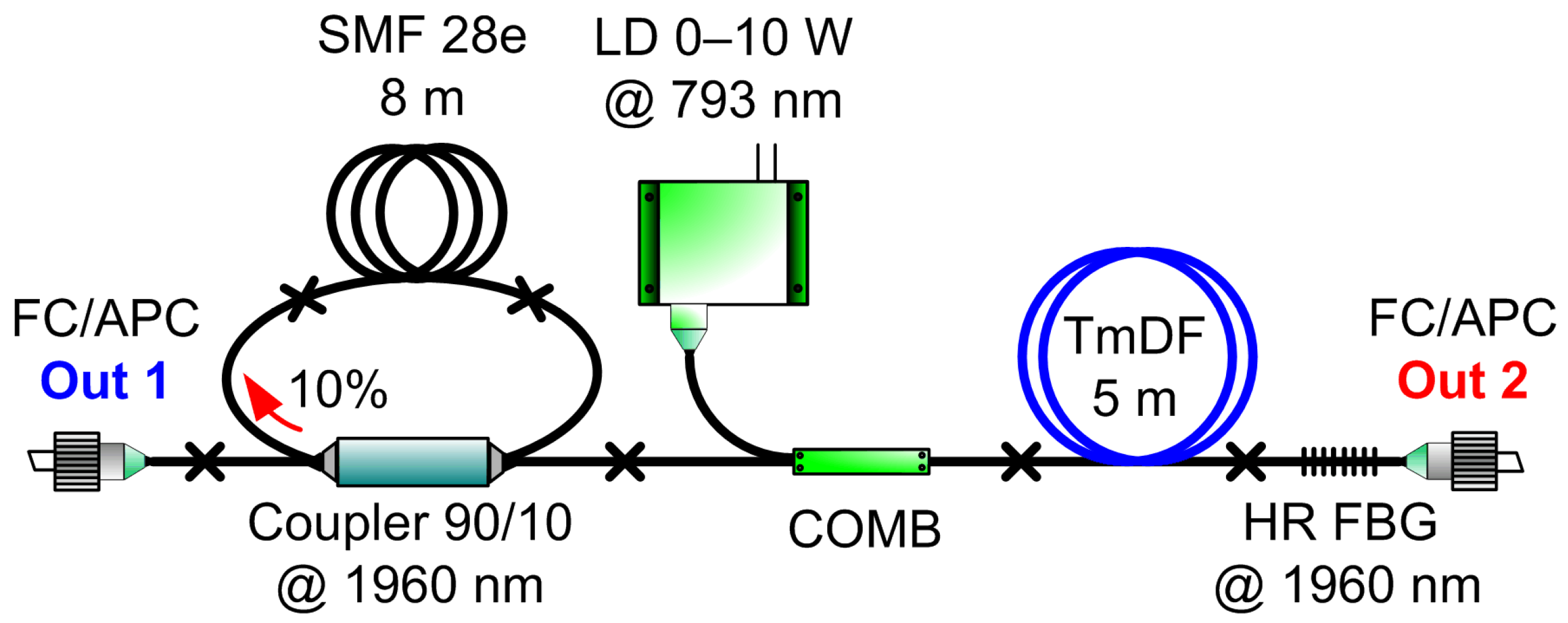
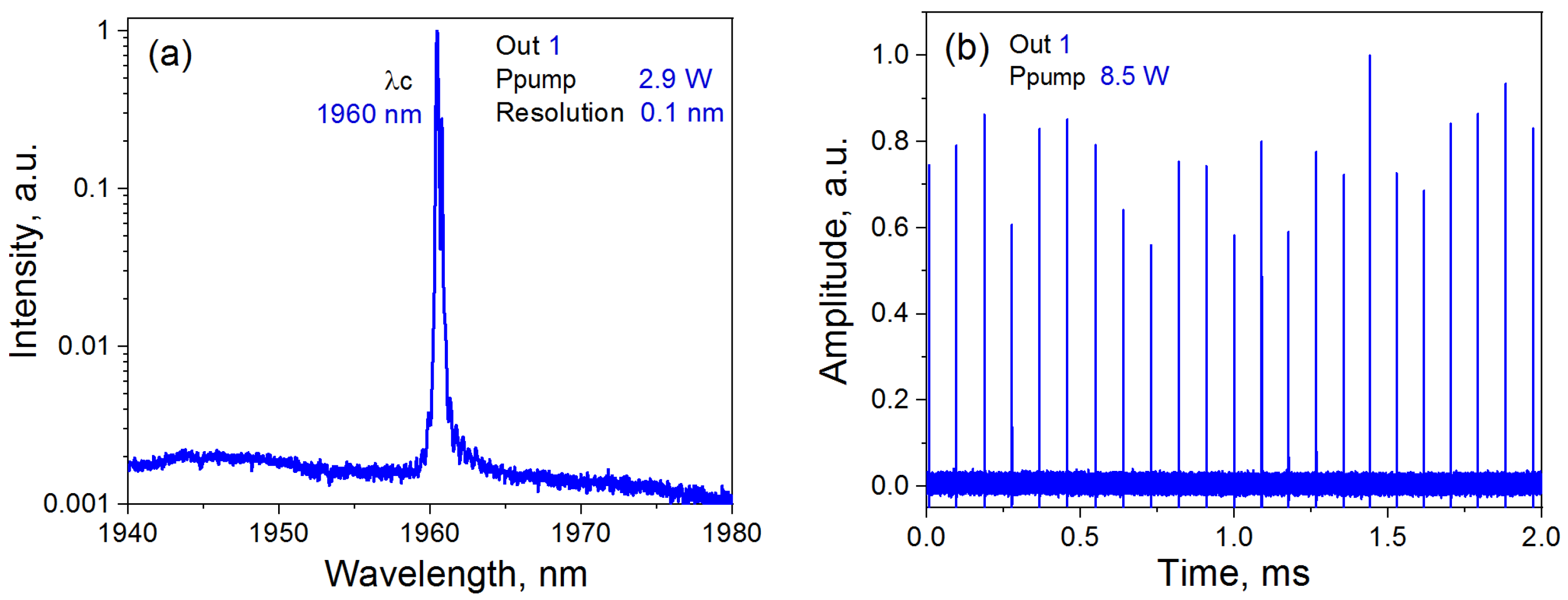
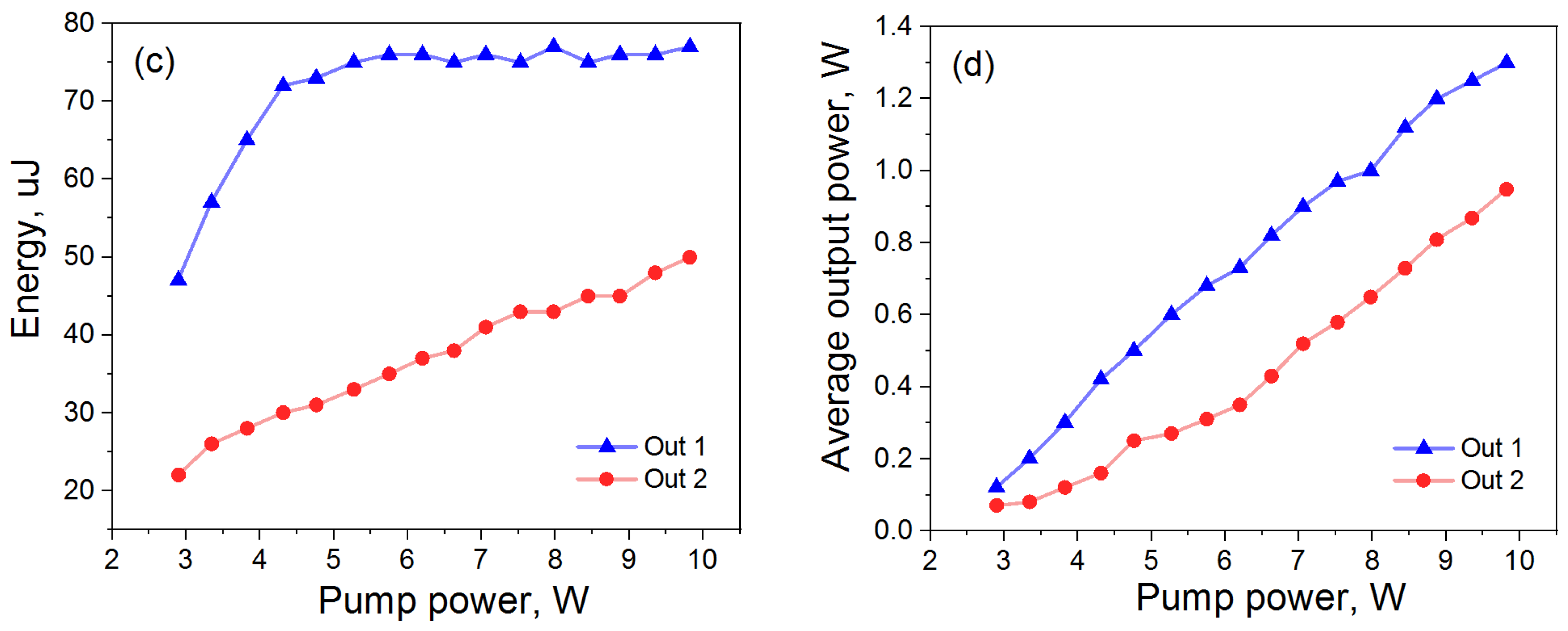
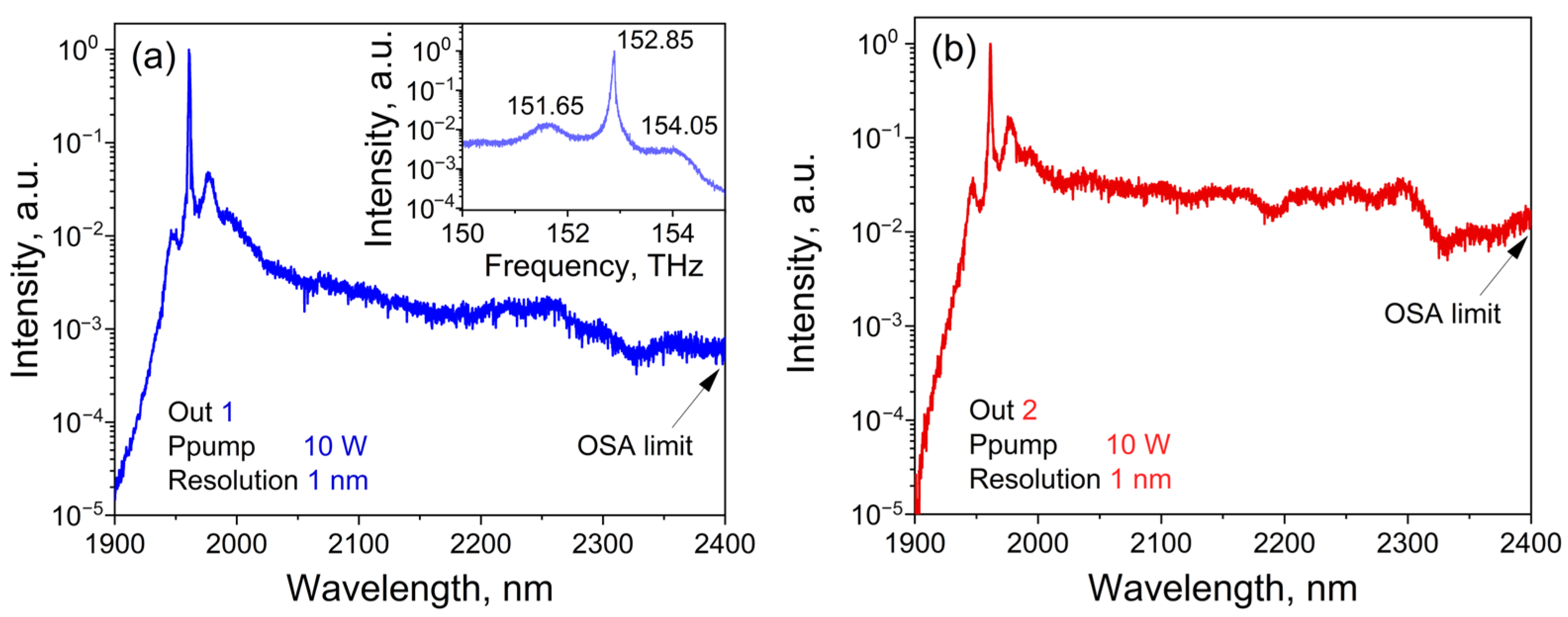
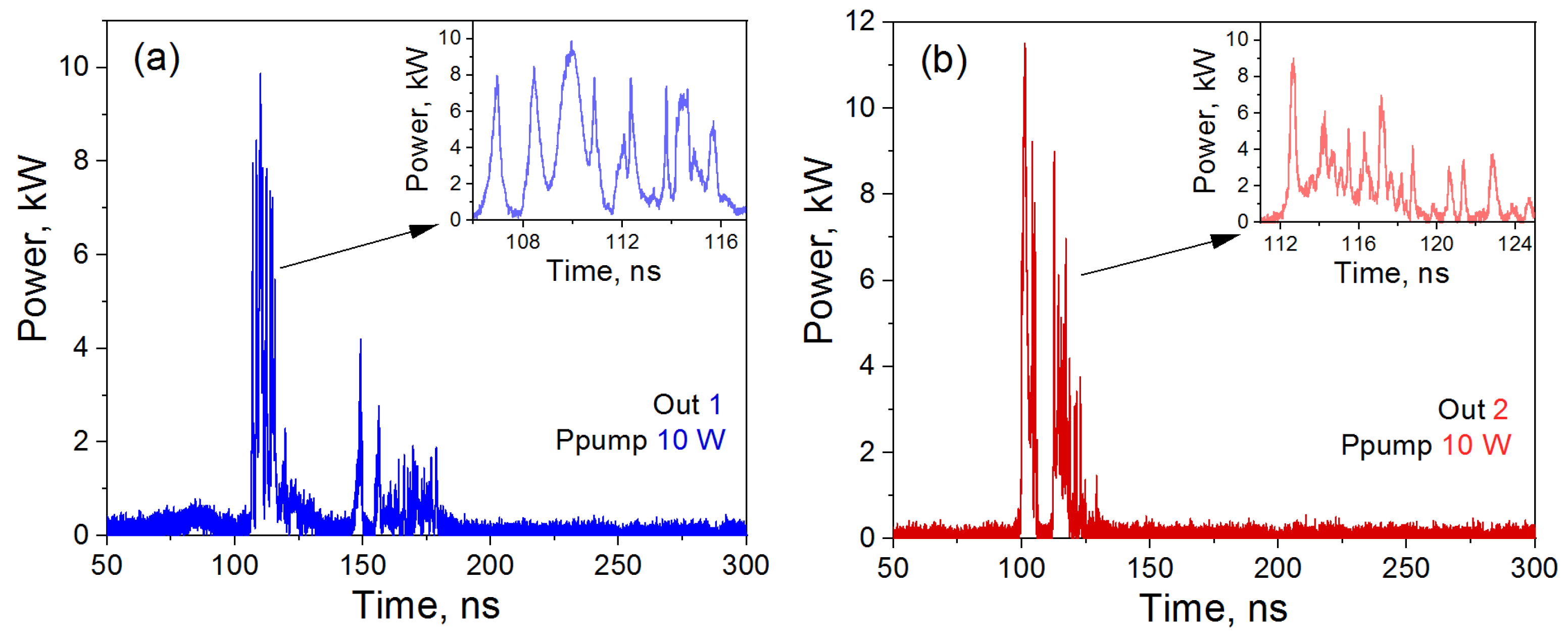
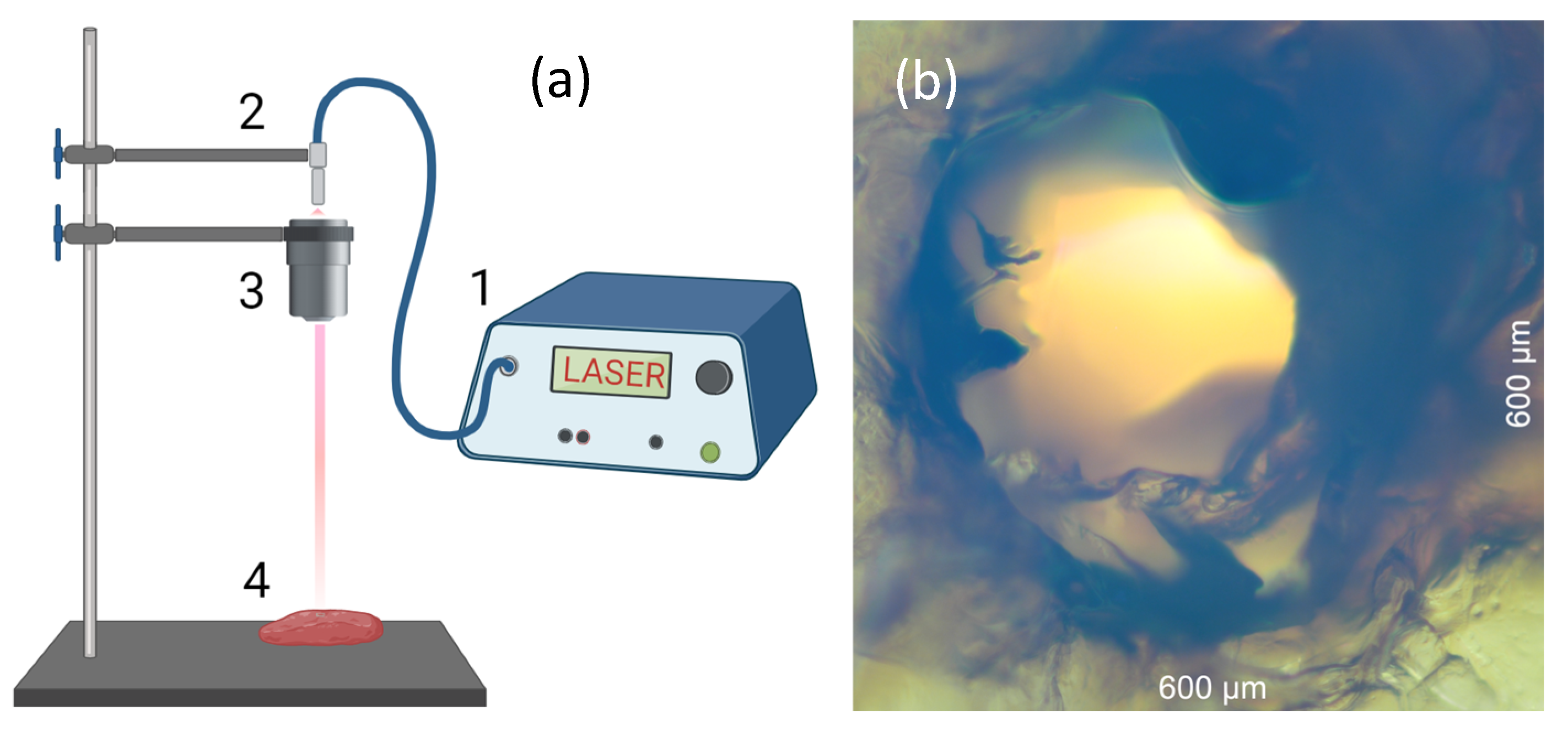
Disclaimer/Publisher’s Note: The statements, opinions and data contained in all publications are solely those of the individual author(s) and contributor(s) and not of MDPI and/or the editor(s). MDPI and/or the editor(s) disclaim responsibility for any injury to people or property resulting from any ideas, methods, instructions or products referred to in the content. |
© 2023 by the authors. Licensee MDPI, Basel, Switzerland. This article is an open access article distributed under the terms and conditions of the Creative Commons Attribution (CC BY) license (https://creativecommons.org/licenses/by/4.0/).
Share and Cite
Kamynin, V.A.; Filatova, S.A.; Mullanurov, T.I.; Cheban, M.D.; Wolf, A.A.; Korobko, D.A.; Fotiadi, A.A.; Tsvetkov, V.B. Fine Structure of High-Energy Pulses from a Stimulated Brillouin Scattering-Assisted Q-Switch Tm-Doped Fiber Laser. Photonics 2024, 11, 30. https://doi.org/10.3390/photonics11010030
Kamynin VA, Filatova SA, Mullanurov TI, Cheban MD, Wolf AA, Korobko DA, Fotiadi AA, Tsvetkov VB. Fine Structure of High-Energy Pulses from a Stimulated Brillouin Scattering-Assisted Q-Switch Tm-Doped Fiber Laser. Photonics. 2024; 11(1):30. https://doi.org/10.3390/photonics11010030
Chicago/Turabian StyleKamynin, Vladimir A., Serafima A. Filatova, Timur I. Mullanurov, Maksim D. Cheban, Alexey A. Wolf, Dmitry A. Korobko, Andrei A. Fotiadi, and Vladimir B. Tsvetkov. 2024. "Fine Structure of High-Energy Pulses from a Stimulated Brillouin Scattering-Assisted Q-Switch Tm-Doped Fiber Laser" Photonics 11, no. 1: 30. https://doi.org/10.3390/photonics11010030
APA StyleKamynin, V. A., Filatova, S. A., Mullanurov, T. I., Cheban, M. D., Wolf, A. A., Korobko, D. A., Fotiadi, A. A., & Tsvetkov, V. B. (2024). Fine Structure of High-Energy Pulses from a Stimulated Brillouin Scattering-Assisted Q-Switch Tm-Doped Fiber Laser. Photonics, 11(1), 30. https://doi.org/10.3390/photonics11010030





